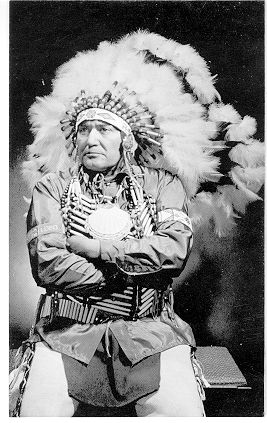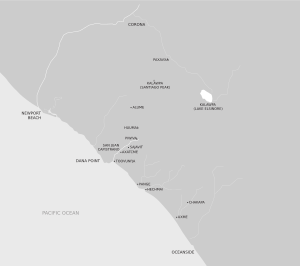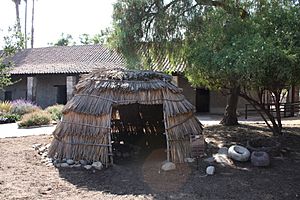Acjachemen facts for kids

Clarence H. Lobo (1912–1985), elected spokesperson of the Juaneño from 1946 to 1985.
|
|
| Total population | |
|---|---|
| about 1,900 | |
| Regions with significant populations | |
| Languages | |
| English, Spanish, and Juaneño | |
| Religion | |
| traditional tribal religion, Christianity |
|
| Related ethnic groups | |
| Payómkawichum (Luiseño), Tongva (Gabrieleño) |
The Acjachemen are an Indigenous people from California. They have lived in the area for a very long time. This area is now parts of Orange, San Diego, Los Angeles, and Riverside Counties.
The Spanish explorers called the Acjachemen "Juaneño." This name came from their baptism at Mission San Juan Capistrano in the late 1700s. Today, many tribe members prefer to use "Acjachemen." This is their original name for themselves. They use it to honor their history and culture.
Their language is very similar to the Luiseño language. This language is spoken by the nearby Payómkawichum (Luiseño) people. In the 1900s, the Juaneño Band of Mission Indians, Acjachemen Nation was formed. However, it is not yet officially recognized by the U.S. government. This lack of recognition makes it harder for them to protect their ancestral lands.
Contents
History of the Acjachemen People
Life Before European Arrival

The Acjachemen people believe they have lived in their homeland forever. This area includes parts of present-day Orange, San Diego, Los Angeles, and Riverside Counties. Old tools and sites show that they have been there for over 10,000 years.
The Acjachemen lived in permanent villages and temporary camps. Villages had between 35 and 300 people. Smaller villages were home to one family group. Larger ones had a main family group and other families. Each family group had its own land for resources. They were independent but connected to other villages. They traded goods and shared religious and social events.
Their society had three main groups. The top group included leaders and religious experts. A middle group had successful families. The third group included people without strong family ties or those captured in wars.
Village leaders were called Nota, or clan chiefs. They led ceremonies and worked with a council of elders. This council made decisions for the community. The Nota and his helpers then carried out these decisions. The main ceremonial building and the chief's home were usually in the center of the village.
The Mission Period
Many Acjachemen villages were located along the San Juan Creek. In 1775, Spanish colonists placed a cross on an Acjachemen sacred site. They left after a revolt at Mission San Diego de Alcalá. They came back a year later to build a mission. They also began converting the Acjachemen people to Christianity. Many early converts were children. Their parents might have hoped to make friends with the missionaries. The missionaries had new goods and knowledge, but also brought the threat of force. Spanish soldiers made sure the mission system continued.
In 1776, Father Serra approached Acjachemen land. He was with a Spanish soldier and a recently baptized Native translator. A group of armed Acjachemen surrounded them. They seemed ready to fight. The translator warned them that fighting would bring more violence from the Spanish army. So, the Acjachemen stopped. They knew the Spanish military was a serious threat.
Before 1783, only a small number of Acjachemen were baptized. But between 1790 and 1812, most of the remaining Acjachemen were baptized. The Spanish called them "Juaneño." This name came from the baptism process at Mission San Juan Capistrano. The mission was named after Saint Juan Capistrano in Spain. Other local tribes were named in a similar way.
By the late 1700s, the mission system controlled all Acjachemen land. Before the Spanish arrived, Acjachemen villages had special areas for hunting, gathering, and fishing. These areas were owned by the community. But the Spanish changed the land. They turned it into grazing areas for animals and farms. Between 1790 and 1804, the mission's animal herds grew from 8,034 to 26,814.
European diseases also spread and caused many deaths among the Acjachemen. This made the Spanish missions even more powerful. By 1812, the mission was at its largest. About 3,340 people had been baptized there. Around 1,361 Juaneños lived at the mission. After 1812, more Juaneños died than were baptized. By 1834, the Juaneño population had dropped to about 800 people.
The Acjachemen tried to keep their culture alive. They practiced their traditional ceremonies and dances. They also performed healing rituals. Missionaries tried to stop these practices. They wanted to prevent old knowledge from passing to younger generations. They put baptized Native children in dorms called monjerios. Children lived there away from their parents from about age seven until they married. Native children and adults were punished for not obeying Spanish priests. They were confined or whipped. A missionary named Gerónimo Boscana worked at San Juan from 1812 to 1822. He said that even with harsh treatment, most Native people did not truly convert to Christian beliefs.
Life Under Mexican Rule
In 1826, Governor José María de Echeandía, the first Mexican governor of Alta California, announced that Native people at some missions were free. This news spread and caused many Native people to resist work or even revolt. At San Juan, the missionary said that if the 956 Native people there in 1827 were asked kindly to work, they would just say they were "free."
After Mexico took control in 1833, Native leaders asked for the land around the mission. This was land the Juaneños had farmed and used to support themselves. The Juaneños were given villages, but they rarely received official legal papers for the land. This meant the land was never formally given to them. They protested as others started using their traditional territory.
By 1841, most of the Acjachemen land was taken over by large Mexican ranches. Even though the Juaneños were now "free," they were often forced to work on public projects. This happened if they were seen as not farming or herding animals in the Spanish way. Because they lacked official land titles, their rights to their village lands were not recognized.
The town of San Juan was formed because settlers from San Diego wanted mission lands. Before the town was created, the 100 or so Juaneños living there were asked if they wanted this change. Seventy voted yes, but thirty, mostly older Juaneños, said no. They might not have wanted to live among the Californios (people of Spanish or Mexican descent). When the town was formed, Californios and Juaneño families were given plots of land for houses and farms.
Modern Day Acjachemen
On December 10, 2021, the Juaneño people celebrated a special event. They opened Putuidem Village. This is a 1.5-acre park in San Juan Capistrano. It is part of their original lands and honors their history.
Acjachemen Religion
Fray Gerónimo Boscana was a Franciscan scholar at San Juan Capistrano. He was there for over ten years starting in 1812. He wrote a detailed study of the Acjachemen's religious practices before the Spanish arrived. Religious knowledge was kept secret. Their main religion, called Chinigchinich, made village chiefs also religious leaders. This gave the chiefs great power.
Boscana divided the Acjachemen into two groups. The "Playanos" lived along the coast. The "Serranos" lived in the mountains. Their beliefs about creation were quite different. The Playanos believed in a powerful, unseen being called "Nocuma." Nocuma created the earth, sea, trees, plants, and all animals. The Serranos believed in two separate but connected beings. These beings created the rocks, sands, trees, plants, and animals.
Acjachemen Language
The Acjachemen language is related to the Luiseño language. The Luiseño tribe lives nearby. The Juaneño language is considered a dialect of Luiseño. It belongs to the Cupan subgroup of the Uto-Aztecan languages.
The Acjachemen language became extinct in the early 1900s. However, the tribe is now working to bring it back. Several members are learning it. Their studies use research and recordings from Anastacia Majel and John P. Harrington. Harrington recorded the language in 1933. These tape recordings were found again around 1995.
Acjachemen Government
The Juaneño Band of Mission Indians has its own government. They elect a tribal council. Tribal elders also help guide the council. The Juaneño Band's main office is in San Juan Capistrano. There are more than 2,800 registered members.
In the 1990s, the Acjachemen Nation split into three different governments. All of them claim to be the Juaneño Band of Mission Indians, Acjachemen Nation.
The Juaneño Band of Mission Indians, Acjachemen Nation-Belardes is recognized by the state of California. In 2006, Orange County officially recognized them as the native people of Orange County. They first asked for federal recognition in 1982. They are working with the Bureau of Indian Affairs to provide the necessary documents.
In the 2000s, the tribe filed a land claim. They want to get back the land of the former Marine Corps Air Station El Toro. This land was once an Indian Ranchería until the 1930s. The U.S. government bought the land then to use as a defense base.
In May 2013, one part of the Acjachemen Nation made history. They elected the first all-female Juaneño tribal council.
Most recently, on July 10, 2021, the Acjachemen Nation elected a new Tribal Council. The members are: Heidi Lee Lucero (Chairwoman), Dr. Richard Rodman (Vice Chairman), Ricky Hernandez (Treasurer), Georgia "Chena" Edmundson (Secretary), Sabrina Banda (Member-At-Large), and Ruth "Cookie" Stoffel (Member-At-Large).
Notable Acjachemen
- Paul "Mocho" Arbiso – A respected elder and bell ringer at Mission San Juan Capistrano.
- Bobbie Banda – An elder who created Native American education programs in public schools.
- Thomas "Happy" Hunn – A respected elder and community leader in San Juan Capistrano.
- Clarence H. Lobo (1912–1985) – A chief, lobbyist, and spokesperson for the Juaneño for 39 years. He helped California Indians get $2.9 million for their lost land. In September 1994, the Clarence Lobo Elementary School opened in San Clemente. It was the first school in California named after a Native American leader.
- Adelia Sandoval – A spiritual leader and cultural director for the Acjachemen nation.
- Jacque Tahuka-Nunez – An educator and storyteller. She was named "Educator of the Year" in 2009 for Native American Studies in California.
- Marian Walkingstick – An elder, basket weaver, writer, and teacher.
- Chief David Belardes – Chief from 1990-2014. He was a tribal scholar, historian, and cultural practitioner.
- Charles Sepulveda - A professor and author.
- Heidi Lee Lucero - Current Chairwoman and a professor at California State University, Long Beach.
Images for kids
See also
 In Spanish: Juaneño para niños
In Spanish: Juaneño para niños









